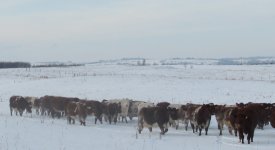trevorgreycattleco
Well-known member
Come on guys, I took Spanish in school! Clueless to what your sayin ;D. I find it fascinating the different types of cows that breeders feel is their optimum cow. Nothing wrong with that at all IMO. When I started to seperate the comers and goers in my herd, it has always been the smaller, longer cows that raised the best calves and stayed in the best shape. Just my expierences. I agree when talking performance. For me its not how big they get, its more how quick they get big enough. I just sent in a steer that was finished on grass. I would put him at a 5.5 frame. He finished in 16 months on grass and hay and had a 657 lb carcass. Maybe not great but IMO enough to turn a profit. I am amazed at the leaness of the meat. Very tender and not weird tasting like many claim. I prefer to eat the meat anyway not the fat. I would like to see the comparison on the relative nutriton in this compared to a grain fattened steer. I know there are studies that favor both sides. In the last two years, every person who has wanted a freezer beef has contacted me because they heard it was grass fed. I have to say demand is growing. Its my niche and I am happy being there. The cattle I have now and bulls I am using are helping me reep the benefits of this market. Plain and simple. If I had a cow that was a 7 frame beast that raised a monster calf every year and stayed in good flesh, she would stay here but I have yet to see that cow thrive on minimum input type production. They always fall out. Hence my reasons for having sour grapes toward trump and rodeo drive. They were the first to earn their ticket to the golden arches in the sky. I REALLY wished it would have been different. I loved those cattle when I first started. It was ALL I had. Tough lesson for me and the banker . ;D Just my thoughts folks.

